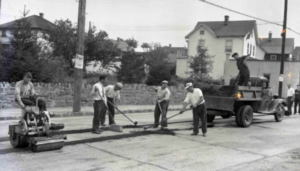Originally written by Carl White.
Road Construction Blast
On Monday, July 23, 1956, the Slattery Contracting Company was blasting rock near the Chickahominy section of Greenwich as part of the construction for Interstate 95. This was 600 yards away from the Armstrong Court Public Housing site. Unfortunately, when a 3,400 lb dynamite blast was triggered around 2 pm, it sent boulders and rocks skyward. It caused minor injuries to some children and adults and caused widespread property damage in the area.
Blast Injuries
Greenwich Time called this the worst blast in Greenwich’s history. Ten children and 3 adults were injured. Four police cars rushed the injured to Greenwich Hospital, where they were treated and released. Most of the children were under the age of 10 years. They had been outside playing near a shelter. The worst injury was suffered by Mr. John Franzetti of Old Field Point Road. He ended up with a fracture of the right ankle, right hip, and right leg. He had been sitting on a wall opposite 364 Hamilton Avenue when 2 rocks hit him. A 100-pound rock left a 4-foot gap in the wall where he had been sitting.
Personal Injuries
Mrs. Katherine Hines of 336 Hamilton Avenue received a head injury from the Chickahominy Blast when she attempted to dive under a truck. A 2-year-old fell off his bed, suffering a head injury, when a boulder smashed through the ceiling and landed on his bed. A 10-inch boulder ripped through the wall of an apartment, but no one was injured. A flying stone smashed through the screen of one woman’s television set! Historic photos indicate rock debris throughout the complex and along the street. There was potential for serious injury, and it’s amazing more people weren’t injured or killed.
Personal Property Injuries
Besides personal injury, there was also extensive damage to personal property. There were 20 holes in a nearby house. Fifty windows were smashed at Armstrong Court, as well as 20 picture windows in living rooms in apartments. Several vehicles received damage from rocks that pelted the rooves and bodies of the cars. Traffic had to be due to the stone on the roads. The New Haven Railroad said their power, signal, and communication lines were damaged by the rocks. Trains had to be delayed by 2 hours, and rocks had to be cleared off the tracks. Thousands of people were delayed. Normal service was resumed the next day (July 24) at 10 am.
Blast Aftermath
The Slattery Contracting Company sent 25 workers to Armstrong Court and environs to clean up all the stone and glass from the Chickahominy Blast. Workers loaded 2 trucks with rock, which was relocated. Some rocks were so big that it took six men to load them into the truck. A superintendent and 2 blasting foremen were arrested by the Greenwich Police. They were charged with failure to take proper precautions. Each was released on a $500 bond and was told to appear in Town Court on July 31. One of the blasting foremen explained that the blast was set to fire in a westerly direction. They didn’t know there was a seam or crevice in the granite that caused the stone to fly southwest. (The stone was a remnant of the Ritch Quarry. This bluestone was used in the Brooklyn Bridge.) One-hundred-thirty-four holes had been drilled 21 feet into the stone for the dynamite.
Safety Precautions
The State Highway Department met with the Slattery Construction Company and Peter Mitchell Construction Company in New Haven to discuss the incident. Slattery agreed to have an expert from the Dupont Explosive Company on hand for future demolition. Other safety procedures were discussed and implemented. As long as proper safety measures are taken, there should never be a reoccurrence of this type of accident again like the Chickahominy Blast of 1956.

SOURCE
Greenwich Time: Dynamite Blast Injures 3 Adults and 10 Children; Southwest Connecticut Newspapers, Stamford CT; July 24, 1956, Page 1.
ABOUT
Build your family tree, dive into the history of your historic home, and discover photos and articles of days gone past with the Library’s collection of 5,000 books, 800 Oral History transcripts, yearbooks, historical maps, vertical files, pamphlets, periodicals, and microfilm and microfiche. Plus, access resources like American Ancestors, AncestryLibrary, and more with a Library card. Learn more at greenwichlibrary.org/genealogy.
Get the latest about the Library’s History & Genealogy events and offerings sent to your email: greenwichlibrary.org/enews.
Questions? Contact:
Local History Librarian
(203) 622-7948
